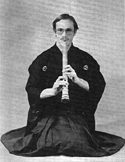| John Kaizan Neptune An Introduction to Shakuhachi |  |
| John Kaizan Neptune An Introduction to Shakuhachi |  |
The shakuhachi is a Japanese end-blownbamboo flute. The name "shakuhachi" is derived from"ishaku hassun" which means one shaku and eight sun(1.8 Japanese feet). Although "shakuhachi" refers tothe standard size instrument and its actual length (54.5 cm or21-1/4 inches), it is also used in the generic sense to referto many different sizes ranging from 1.3 shaku (39.4 cm) to 2.5shaku (75.7 cm) and longer.
The shakuhachi is made from the rootportion of a thick-walled bamboo called madake in Japanese (scientificname, Phyllostachys bambusoides). The bamboo is cut belowground level and the roots form a natural bell for the instrument.If the roots are damaged, they may be shaved off, but the generalpractice is to leave the small root protrusions intact. For anumber of reason modern shakuhachi are usually made so that theycan be taken apart at the center: first, to construct a fluteof the proper length with the right placement of holes in relationto joints, a portion is usually cut from the center of the bamboo,and second, it is easier to work on the bamboo when it is onlyhalf the total length.
Construction of the shakuhachi is anexacting process requiring many steps. The bamboo is cut, theoils are removed, and it is aged from six months to two years,or sometimes longer. Often the natural curve of the bamboo requiresalteration. The internal nodes must be hollowed out using specialchisels and files. Gauges are used to achieve the interior diameterrequired for correct pitch and sound. Even though the exteriordiameter may vary considerably, the interior is accurately constructedand generally tapers slightly inward toward the base. Of course,proper placement of the holes is a very important step, and theapplication of special lacquer to the interior requires considerableskill.
The most important part of the shakuhachi--the sharp blowing edge-- is cut obliquely and has an inset ofwater buffalo horn, ivory, or (more recently) black acrylic plastic.The air stream is focused-- split-- over this sharp edge, settingup vibrations in the air, causing the sound.
Although the standard shakuhachi isfive holes, four in front and one in back, there are also seven-and nine- holed flutes. Starting with all fingers closed, thestandard shakuhachi produces the pitches D F G A C. However, onmany flutes, especially older ones, the tuning may not correspondto Western pitches. Three full octaves are possible on the shakuhachi,although generally only a little more than two octaves are used.
Because of the individual characteristicsof each bamboo, no two flutes are alike and an element of chanceenters into the construction of an excellent shakuhachi. Thiselement, and the high degree of skill and experience necessaryto construct a flute are two reasons for the high cost of a goodshakuhachi. The shakuhachi is simple looking but very expressive,being capable of a truly remarkable range of pitch, tone color,and dynamics.
According to some legends, the shakuhachiwas brought from China to Japan more than a thousand years agoby a Zen priest. During the Edo Period (1615-1868) the shakuhachiwas played by wandering priests called "komuso"--"priestsof emptiness and nothingness". The komuso used the shakuhachias a way of "blowing Zen".
Today, performances of traditional musicare common and new pieces are being written for shakuhachi soloand ensemble, and for shakuhachi in combination with other Japaneseand/or other instruments from around the world.